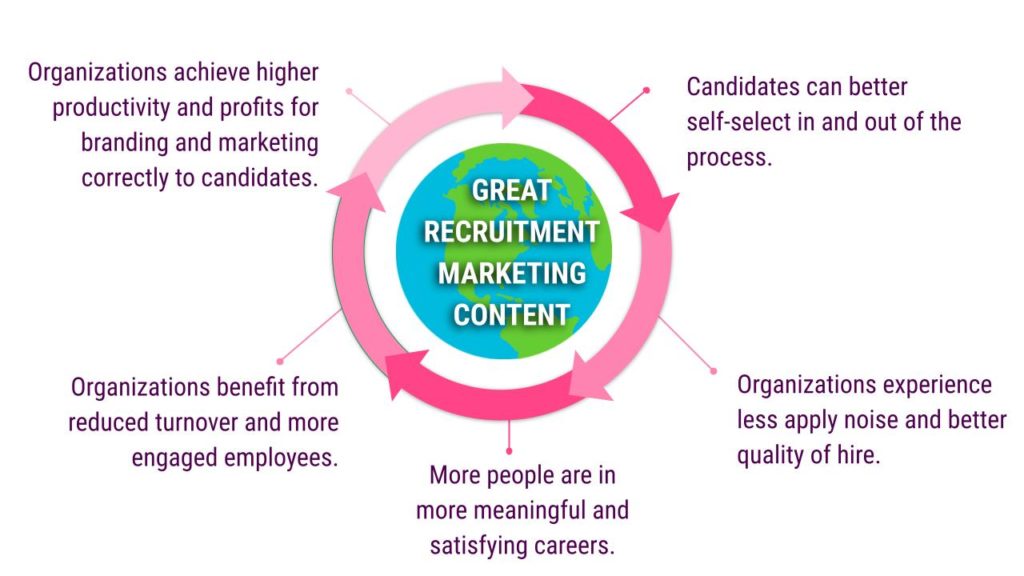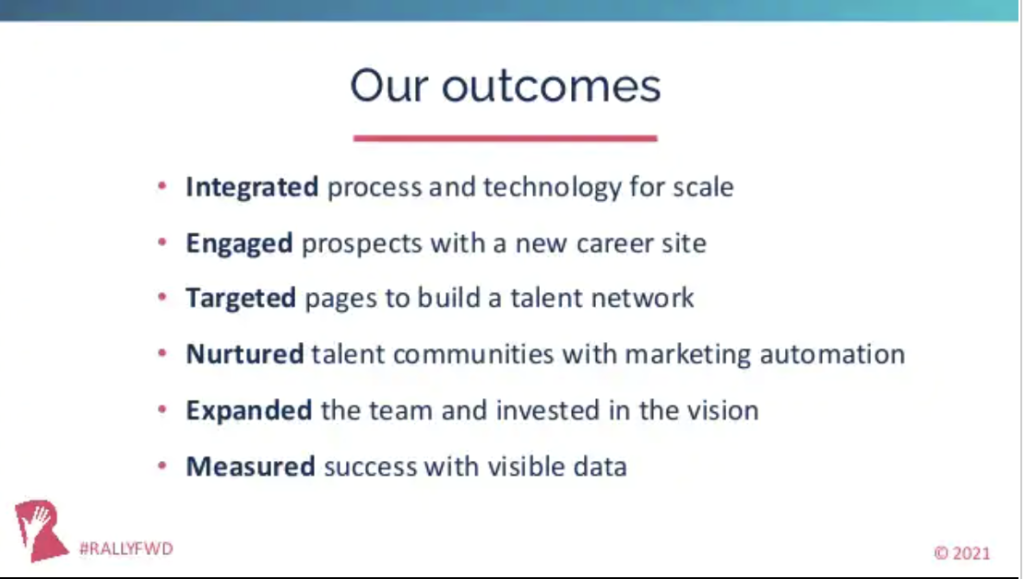RallyFwd Recap: Forward-Thinking Recruitment Marketing Strategies
RallyFwd brings together thousands of recruitment marketing professionals for presentations packed with forward-thinking recruitment marketing strategies that level up employer branding skills. Given the recruiting challenges today, sessions focused on what employer branding and recruitment marketing professionals can do in 2022 to level up their skills and prepare for yet another interesting year. In case you missed it or want to review the essentials , Stories Incorporated has the RallyFwd recap!
Economic Conditions Impacting the 2022 Labor Market
Andrew Flowers, Appcast
Andrew Flowers, Lead Labor Economist at Appcast, set the stage for what could happen in 2022. Long-term factors that could impact recruiting include inflation’s impact on the labor market and the fundamental mismatch between worker supply and demand.
Andrew shared how that the gap between demand for workers and the supply of hireable workers is what’s making recruitment so difficult right now, with no fix in sight:
- Pre-pandemic 2020: 102 million prime-age workers
- August 2021: 10.4 million open positions
- October 2021: 98.7 million prime-age workers
Nearly 3 million prime-age workers have not returned to work, and with so many open positions to fill, demand and competition will continue to be high! COVID, government policy, and The Great Resignation have all contributed to this problem.
And, with consumer inflation at a 30-year high, Andrew wonders if this supply/demand recruiting problem is transitory. Andrew shared that three factors will have long-term impacts on recruiting: demographics, technology, and politics.
Using Analytics to Fast-Track Your Career
Lori Sylvia, Rally Recruitment Marketing
Lori Sylvia, Founder & CEO of Rally Recruitment Marketing discussed how recruitment marketers can further their influence and career by understanding their “data story.”
Importantly, when you can use data to show what your efforts are producing, you can more easily show the value you are bringing to an organization. Part of your job is to educate others about what you do. Turn your data into a story and show the impact that you are making every single day. And remember, “You can’t measure what you don’t track!”
Missed Opportunities in Employee Storytelling
Lauryn Sargent, Stories Incorporated
Our own Lauryn Sargent, Co-Founder & Partner at Stories Inc., started off by reiterating how important it is to have good recruitment marketing content that gives clarity to candidates. When you are clear about who you are, you will attract talent that will thrive in your environment. In turn, organizations achieve higher productivity and profits. Happier people, better run companies, better world.

Using Stories Inc.’s experience getting a great story, every time, from any person, she outlined a few tips:
Stories Inc.’s Tips for Getting a Great Story, Every Time
- facilitate the process from start to finish
- have balanced storyteller prep
- come with the map (know who you are interviewing and why)
- dig for professional and personal experiences
The best recruitment marketing content is conversational and natural. Honoring these employee stories requires thought and attention so it must be treated as a big deal. Next, Lauryn dives into how to capitalize on candidate attention. Some tips that Lauryn gave were:
How to Capitalize on Candidate Attention
- Use stories, not testimonials
- Use them the right way
- Make it real/ ground concepts
- Visual and audio quality
- Be timely and timeless
Don’t waste your candidate’s time with generic content! Once you have these great stories, use them immediately. Your candidates want insight into your culture and are not going to sift through all of your content to get to the good stuff. Candidates want real stories and a great way to do that is by connecting them to strategic messaging.
Stories Inc. also squeezes all the ROI out of every asset. They do this by getting the most out of every interview, optimizing the asset/story per channel, and furthering reach and gaining new audiences by sharing your content with internal stakeholders. Repurposing stories and content for different social channels can help you get the most out of your content. One employee story can be a LinkedIn post, Instagram story/post, or a blog and this will maximize your reach.

Employer Brand Strategies that Your Organization Will Sit Up and Listen To
Bryan Adams, Ph.Creative
Bryan Adams, CEO & Founder of PH.Creative, shared ways recruitment marketers can communicate with internal stakeholders and leaders to get their attention. His insights sought to help attendees’ align with their leaders’ existing priorities when asking for time and budget.
Even though everyone acknowledges how important employer branding is, it does not always get conveyed to internal stakeholders in the wider business. The first thing that Bryan introduced was the employer brand strategic model.
- Develop an employer brand: this is designed to get the attention of your audience internally and externally
- Design an appropriate Employee Value Proposition (EVP): capture the proposition/consideration stage of the company marketing funnel
- Deploy your brand experience: create affection and real human connection with active candidates
Essentially, your employer brand is there to create a reputation, create a proposition, and prioritize experience. By breaking it into these three things, you then have three separate areas of employer brand strategy that can be measured and tracked to determine what’s working, what’s not working, and what can be improved.
Following up on that, Bryan discussed the strategic focus on reputation as an employer. Bryan advised attendees to to consider the three C’s: career catalyst, culture, and citizenship. Once you determine which “C” your organization is, you have something very tangible to take to your leadership and start aligning with existing priorities.
Adapting to the Hybrid Candidate Journey
Hanady Khourshid & Andrew Mott, CDW
CDW’s Hanady Khourshid, Manager of Employer Brand & Diversity, and Andrew Mott, Senior Manager of Talent Acquisition Technology, Process, and Operations, spoke about adapting to the hybrid candidate journey.
They took the audience through the following steps of the candidate journey:

From Awareness through to Advocacy, Hanady and Andrew gave a ton of tips to ensure candidates are constantly being engaged throughout the entire process. Andrew also emphasized that internal teams should always be on the same page about the process.
The Power of a Proactive Approach
Jessica Rose, Equinix
Jessica Rose shared her experience as Director of Global Talent Marketing at Equinix as they encountered three main challenges while shifting their hiring strategy from reactive to proactive.
Solving for Growth
Experiencing rapid growth at Equinix helped HR realize that they needed to increase their capabilities. This initiative prompted them to create warm talent communities and amplify their employer brand.
Solving for Process
The team couldn’t scale using their existing processes. So, they need to invest in an infrastructure that would allow them to pioneer recruitment marketing internally and better teach talent marketing concepts.
Solving for Visibility
Jessica created a business case, gathered KPIs as proof points, and measured progress and influence.
Equinix achieved marked results from shifting its hiring strategy from reactive to proactive:

The Candidate Experience Trinity: Tech, Process & People
Craig Fisher, TalentNet Media
“Is remote work here to stay?” Yes, says Craig Fisher, Founder of TalentNet Media. He pointed out that employers that promote flexibility are having more success attracting job candidates. In addition to this, 69 percent of Gen Z candidates said they would select a hybrid workplace over one that doesn’t offer the option.
Craig also shared tips for increasing the speed of responding to job applicants. He noted that this is crucial because candidates today are applying to so many jobs at once with quick apply tools.
And, Craig provided best practices for LinkedIn, SEO, and inbound marketing to help candidates easily find you as a talent professional or hiring manager. He gave an example of a perfect LinkedIn profile and advises recruiters to include keywords geared towards targeted talent, including the word “jobs.” He also recommends using a 5:1 ratio when posting content, which is five gives (education or helpful posts) to every one ask (posts about your company).
An Exciting 2022 Awaits
We end our RallyFwd Recap with these words from Lauryn that can serve as a “rally”-ing cry for all of us recruitment marketers in the year ahead:
“Let’s all raise our collective employee storytelling bar and maximize our marketing efforts!”
Thanks for a great conference RallyFwd!

